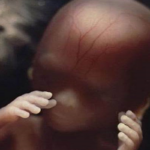Blog Post
This is late-term abortion–described by a mom who had one because her child would have been disabled
By Jonathon Van Maren
This article was first published in February of 2019.
I’ve studied abortion and the reality of the different abortion procedures many times, but every once in awhile I still stumble across something that disturbs me. Recently, it was an article emailed to me by a friend in the pro-life movement titled “The Mom Who Had An Abortion At Seven Months Pregnant,” by the mother of three who had made that choice after discovering that her pre-born child would in all likelihood be severely disabled—even though her initial reaction to the pregnancy was that she was “unambiguously happy.” After she was told by a specialist about the problems her child faced, however, “It was a fairly easy decision. My husband and I just sort of looked at each other, and I told them to call the clinic. It was not really a question for me.”
The author of this essay is extremely blunt, and so I just want to share a few excerpts that I think highlight the reality of late-term abortion. First, it had an enormous impact on both her and her family:
When you have kids, you don’t want to cry in front of them. I cried in the kitchen; I cried in the laundry room. I cried in the car. I just kept finding places to cry where the kids wouldn’t see me. Right before we left, we had to tell my son what was happening, which was rough, but I didn’t want to leave pregnant and come back not pregnant without telling him anything. We told him the truth, using child-friendly terminology. We told him the baby was too sick to live outside of Mommy, so a doctor is going to take the baby outside of Mommy and there’s not going to be a baby we bring home and the baby is going to die. Our son was sad for about five minutes. From what I understand, it comes and goes for him. Just the other day, my daughter was looking for her doll and saying, “Where is the little baby boy? I can’t find my little baby boy!” And my son said, “She’s talking about the baby, the baby who died. Can we have a birthday party for him this year, because someone good left the world and we should remember that?” I was eight months pregnant when I had the abortion, and he had expectations. As the grown-up, I believe I have to take care of his emotional needs — so I told him no, we weren’t going to have a birthday party, and that a baby who dies before it’s born isn’t a person in the same way.
How heartbreaking that this awful, dehumanizing language was passed on to the little brother like that—and that even his simple way of remembering the sibling he never met was dismissed as unnecessary. Her description of the procedure itself, later in the essay, is gut-wrenching:
My abortion happened over four days. The first day they do what’s called “feticide”; I’m not sure how I feel about that word, but that’s what they call it. That’s definitely the most emotionally difficult day, because they have to inject the baby with a chemical that stops the heart…They do an ultrasound, because they need the guidance — if the doctor can’t see what he’s doing, he might stick a needle in an organ. But they put the screen so you can’t see it. They have a social worker to hold your hand, and a nurse to be a nurse. They did an amnio first, as a favor, since we didn’t know why the baby had such severe microcephaly. Then the chemical was injected. It was similar to an amnio — a long needle into the uterus. The doctor missed, the first time.
No one talked about it. I think they didn’t want to upset me. I mean, he was trying to hit a moving target that he could only see on what must have been a 30-year-old ultrasound machine. But what was so hard about it, for me, was the baby had woken up. He’d started moving. That was really, really hard. It goes against every human instinct, to lie there and let someone do that. You’re not supposed to move, so I was trying not to cry and not to move. I just remember thinking, Go to sleep. Don’t move, because we have to do this. I think the fact that I believed that and still do, helps. That this was the best of all possible decisions. But it was still really f*****.
The doctor did get it the second time. It was very fast. I think probably because the baby’s body was already so weak. He kicked once, after the shot. That was the last time I felt anything.
She then describes how she made funeral arrangements for the baby who was “almost a person, but wasn’t.” Despite her brutal honesty throughout the essay, she clings to the fiction that her pre-born son wasn’t a real person, because then the truth would simply be too much for her. Her description of the reality of the procedure is blunt, and it is actually hard to believe she was willing to face what her pre-born child went through:
There’s no other way to say it: A D&E tears the body to pieces. Sometimes the very physical parts of having this kind of abortion feels like something we’re not supposed to talk about, especially if we want to keep laws off our bodies. I think the fact that this feels like a visceral horror to some women — though not all — and then is used as an excuse to write disgusting legislation is awful. But I don’t know that the solution is to not talk about it.
This is already a violating procedure. You’re ending the life of the child, the fetus, whatever you want to call it. There was just something so horrifying about not just ending the pregnancy, but having the body torn into pieces.It felt like one last violation of how you are supposed to be able to protect your child — not to be able to protect the physical integrity/privacy of the body, to have it be exposed like that. I had wanted the body to be shown respect. It felt like one of the only things I could do for him.
Before the D&E, I had a lot of painkillers, but I was not sedated. There’s not an anesthesiologist on staff and no way to resuscitate a patient, so it just wasn’t safe to put me under. I could hear and feel everything. I remember everyone talking. I remember the doctor breathing really heavily, like it was hard work — which I guess it is. Surgery in general is more physical than people realize. It was quite painful — not as painful as natural labor, but painful. I remember one of the nurses told the social worker, in the most loving way possible, to keep me quiet because I was going to scare the other patient. I could hear the noise of the instruments, the metal click that forceps make. The drop of whatever he was dropping into the tray, which I was trying really hard not to think about.
Afterward, they wrapped his remains in a prayer shawl and put them in a coffin to bury, and we buried him four days after we got back.
That is the reality of late-term abortion: An abortionist sweating with the effort of crushing a nearly full-term baby’s skull and tearing his body to pieces, before dropping those pieces on a tray so that a nurse can piece him back together to make sure nothing got left behind. And then, the doctors can place their fresh kill in a coffin so that the little boy’s shattered corpse can be given the respect he was denied in life.
That is the reality of late-term abortion.









U gotta be kidding! U already have a gender
O God! It’s brutal. We as women have been blessed and entrusted with the ability (“power “)of being Co-Creators with God; to bring forth life. Alas! We choose to destroyers of precious life.